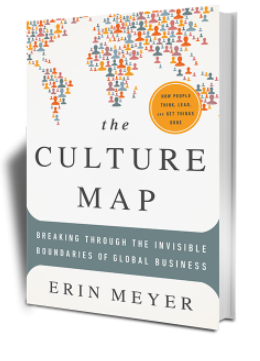In 2016, the world’s airlines carried 1,560,775,000 international passengers. That’s a lot of people. Also in 2016, the value of exported manufactured goods worldwide was US 11.2 trillion. That’s a lot of stuff. With all those people moving around, buying and selling, the opportunities for cultural misunderstandings world-wide must be astronomical. So I have to tell you about this book.
Erin Meyer, the author of the Culture Map, is a professor at INSEAD, an international business school in France. Her work focuses on how international managers navigate the complexities of cultural differences in a global environment. She is a regular contributor to the Harvard Business Review and was selected by HR Magazine as one of its most influential thinkers of 2017. In the Culture Map she channels her INSEAD research to show how cultural differences impact international business.
The Culture map is set of eight behavioural scales covering the most common business communication challenges that come from cultural differences. These challenges: time perception, decision-making, leadership, disagreement, trust, feedback, persuading and effective communication, are laid out in eight chapters filled with background research, anecdotal insight and strategies for dealing with them.
The scales themselves bookend the two cultural extremes for each concept, and then place different cultures on the scale relative to one another. For example, on the communication scale, the contrasting styles are, at one end, Low-Context, and at the other, High-Context. Low-Context societies, like most Anglo-Saxon countries, consider good communication to be clear, precise and simple. Messages are sent and received at face value. Repetition is appreciated if it helps with clarity. While at the other end of the scale, in High-Context societies such as Korea and Japan, good communication is considered nuanced, layered and sophisticated. It is necessary to read between the lines as messages are often implied and not expressed in plain language.
These scales aren’t grades, like you get a 10 for being a good communicator, so a society or country does not have an absolute position on a scale. Rather countries are positioned relative to each other. A good example that Ms Meyer uses is between the U.S. and U.K. Both are on the Low-Context side of the scale yet Americans are often unable to discern the straight-faced sarcastic or ironic humour typical of the British. Where an American would add “just kidding” after telling a joke, the British, in their higher context culture would feel that if you have to tell someone it’s a joke, why bother telling it at all.
The other seven scales are given a chapter each and are as follows:
- Evaluating – Direct negative feedback vs. Indirect negative feedback
- Leading – Egalitarian vs. hierarchal
- Deciding – Consensual vs. Top-down
- Trusting – Task-based vs. Relationship-based
- Disagreeing – Confrontational vs Avoids confrontation
- Scheduling – Linear-time vs. Flexible-time
- Persuading – Principles or theory first vs. Application first
Ms Meyer takes into account the history, philosophy and social science of cultures and bringing together both her own and other’s extensive academic research, creates this functional eight-scale model that provides a practical framework for understanding and preventing cultural differences. In each chapter she explains how the scales operate while weaving in personal stories of cultural communication problems and how to handle them. It is both enlightening and enjoyable to read and I found myself recalling my own situations and applying the concepts as I read along.
In fact, when researching cultural awareness for a business skills workshop I was preparing, I found Ms Meyer’s concepts and how she presents them so practical and easily applied that I’ve included this book as a key part of my cultural awareness workshops. Everyone who does business internationally should read the Culture Map.
And as a final thought. While this book was written for a business audience, I feel the Culture Map transcends business and can be thoughtfully applied to most situations where there is potential for cultural miscommunication. To finally understand why my Polish students always need to know the grammar, why my Dutch client gave such harsh criticisms one day and was friendly and jovial the next, and why my Libyan students would wander into class seemingly whenever they wanted; this is the practical application of this book for me, and I wish I had had it 20 years ago when I first started my international journeys. There would have been a lot fewer mistakes along the way.
The Culture Map: Breaking through the Invisible boundaries of Global Business, by Erin Meyer. First Edition Published by Public Affairs TM, a member of the Perseus Books Group. 2014. ISBN 978-1-61039-259-4 (e-book)
